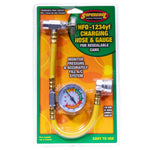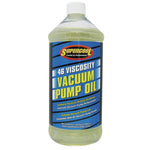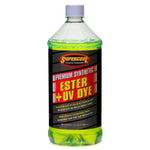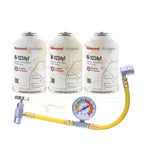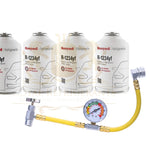You have no items in your shopping cart.

Is your AC not cooling like it used to? The problem might be related to the refrigerant—specifically, R-410A. This powerful compound plays a crucial role in keeping your home cool and comfortable. In this article, we’ll break down what R-410A refrigerant is, how it works, and why it matters for modern HVAC systems.
Keep reading to discover everything you need to know about this essential refrigerant!
Key Takeaways
-
R-410A is a refrigerant used in modern air conditioners and heat pumps. It absorbs and releases heat efficiently, keeping homes cool or warm.
-
Unlike older refrigerants like R-22, R-410A does not harm the ozone layer because it contains no chlorine.
-
It operates at higher pressure levels, offering up to 50% better cooling capacity than outdated options like R-22.
-
The HVAC industry switched to R-410A for its eco-friendly properties and improved energy efficiency under regulations like the Montreal Protocol.
-
Regular maintenance ensures systems using R-410A work effectively to maintain home comfort year-round.
What Is R-410A Refrigerant, and Why Is It Important for Modern AC Systems?
R-410A refrigerant is a cooling agent used in many modern air conditioners and heat pumps. It helps these systems transfer heat efficiently, allowing your home to stay cool in summer or warm in winter.

This refrigerant replaced older options like R-22 due to its better energy efficiency and lower environmental impact.
"R-410A has no ozone-depleting potential, making it an eco-friendlier choice."
It can handle higher pressure levels than older refrigerants, which improves performance. Modern HVAC units are designed specifically for 410a refrigerant to enhance durability and reliability over time.
How Does R-410A Refrigerant Work in Air Conditioners and Heat Pumps?
Modern air conditioners and heat pumps rely on refrigerants to cool or heat spaces. R410A refrigerant absorbs heat from inside your home and releases it outside. It works in a closed-loop system consisting of compressors, coils, and fans.
The process starts with the compressor pressurizing the R-410A gas into a high-temperature state. This hot gas flows through outdoor condenser coils, where fans blow air to remove the heat.
After releasing the heat, the refrigerant changes into a liquid form as it cools down. It then travels to indoor evaporator coils while still under pressure. At this point, it expands back into a colder gas by reducing its pressure levels quickly.
As warm air passes over these cold coils indoors, the 410A refrigerant pulls out moisture and lowers temperatures in rooms effectively.
What Makes R-410A Different From Other Refrigerants Like R-22?
R-410A refrigerant absorbs and releases heat more efficiently than R-22. It operates at higher pressures, making it better for modern air conditioners designed for efficiency. Systems using R 410A refrigerant also cool faster and use less energy.
Unlike R-22, R-410A does not harm the ozone layer because it contains no chlorine. This makes it an eco-friendly choice under environmental regulations like the Montreal Protocol. Next, explore how this refrigerant circulates in HVAC systems to provide cooling.
How Does R-410A Circulate and Cool Air in an HVAC System?
R-410A works through a closed-loop system. The refrigerant absorbs heat from indoor air as it changes from liquid to gas in the evaporator coil. At this stage, it cools the air blown into the home.

A compressor then pressurizes the R-410A gas and turns it back into liquid. This transformation releases heat outside via condenser coils. The high-pressure properties of 410 a refrigerant make cooling faster and more efficient compared to older types like R-22.
R-410A offers up to 50% higher cooling capacity than outdated refrigerants.
What Are the Key Properties of R-410A That Make It So Effective?
R-410 A refrigerant absorbs and releases heat more efficiently than older options like R-22. Its higher pressure capacity allows HVAC systems to operate with better cooling performance.
This helps air conditioners and heat pumps work more effectively in hot weather.
This refrigerant has a lower environmental impact compared to many alternatives. It does not deplete the ozone layer, making it an eco-friendly choice. These unique properties improve energy efficiency and ensure reliable operation for modern HVAC systems.
Explore why the industry switched to this advanced option in the next section.
Why Did the HVAC Industry Switch to R-410A Refrigerant?
The HVAC industry switched to R-410A refrigerant due to its eco-friendly properties. Unlike R-22, it does not harm the ozone layer. This change became necessary after environmental concerns arose about older refrigerants.
R-410A also performs better in modern air conditioners and heat pumps. It absorbs and releases heat more efficiently, improving system performance. These benefits make refrigerant 410A a reliable choice for cooling systems today.
How Does the Refrigeration Cycle Work With R-410A?
R-410A refrigerant moves through the refrigeration cycle in a closed loop. It starts as a low-pressure gas in the evaporator coil, absorbing heat from indoor air. A compressor then pressurizes it into a high-temperature, high-pressure gas.
The hot gas flows to the condenser coil outside and releases heat into the outdoor air. As it cools, R-410A turns into a liquid. This liquid passes through an expansion device, lowering its pressure and temperature again.
It re-enters the evaporator to repeat the process and keep cooling your home efficiently.
What Should Homeowners Know About R-410A and How It Works?
Homeowners should know that R-410A refrigerant is safe and efficient for modern AC systems. It replaced older refrigerants like R-22, which harmed the ozone layer. Unlike R-22, it does not contain chlorine, making it environmentally friendly.
This refrigerant absorbs heat from indoor air and releases it outside. It works under higher pressure than older types, so your system needs compatible components. If you need repairs or recharges, experts can easily handle systems using R410a refrigerant for sale today.
Regular maintenance ensures the system uses freon r410a effectively to cool your home.
FAQ
1. Is R-410A refrigerant still being used in new HVAC systems?
Yes, R-410A is still commonly used in many HVAC systems, though the industry is gradually transitioning to newer refrigerants with even lower global warming potential (GWP), such as R-32 and R-454B. Always check with your HVAC manufacturer for system compatibility.
2. Can I use R-410A in an older system that originally used R-22?
No, R-410A cannot be used in systems designed for R-22. The two refrigerants operate at different pressure levels, and retrofitting is not recommended due to safety and performance concerns. It’s best to upgrade to a compatible system.
3. How do I know if my air conditioner uses R-410A?
You can usually find this information on the unit’s nameplate or manufacturer’s label, often located on the outdoor condenser. If you’re unsure, an HVAC technician can confirm the type of refrigerant your system uses.
4. Is R-410A being phased out?
While R-410A is not being phased out as urgently as R-22 was, its high global warming potential means that future regulations may limit its use. Some manufacturers have already begun shifting to next-generation refrigerants.
5. What should I do if my system is low on R-410A?
If your system is low on R-410A, it likely has a leak that should be identified and repaired by a licensed HVAC technician. Simply refilling without fixing the leak is not recommended and may lead to more damage over time.
Conclusion
R-410A refrigerant is the backbone of today’s energy-efficient, environmentally responsible HVAC systems. It not only cools your home effectively but also supports a greener future by reducing ozone depletion. Understanding how it works can help you make informed decisions when installing, repairing, or upgrading your air conditioning system.
For maximum comfort and performance, regular maintenance of your R-410A system is key. Royal Refrigerants provides premium R-410A and a complete selection of HVAC refrigerants—delivered quickly and supported by expert service. Get in touch with us to learn more about R-410A and keep your systems operating at their best.
 English
English


